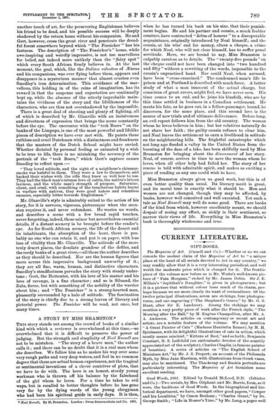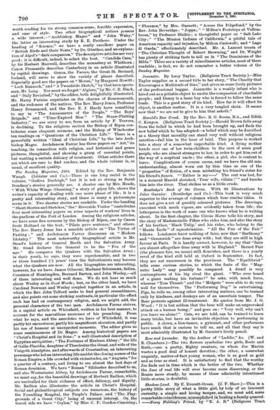Good Words, 1891. Edited by Donald McLeod, D.D. (Isbister and
Co.)—Two serials, by Mrs. Oliphant and Mr. Barrie, form, as it were, the backbone of Good Words. In the biographical and his- torical department, we have, amongst other good papers, " Cowper and his Localities," by Canon Benham ; "Charles Grant," by Dr. George Smith ; " Life in Homer's Time," by Mr. Lang, a paper well
worth reading for its strong common-sense, forcible expression, and ease of style. Two other biographical notices possess a wide interest,—" Archbishop Magee" and " John Wahy,"
the latter an interesting- study by R. E. Prothero. Under the heading of Science," wo have a really excellent paper on
" British Birds and their Nests," by Dr. Gunther, and an explana- tion of Algol's " dark companion." The descriptive articles are very good ; it is difficult, indeed, to select the best. " Candida Casa," by Sir Herbert Maxwell, describes the monastery at Whithorn ; Canon Fremantle describes Canterbury in an article illustrated by capital drawings. Genoa, the Faroes, the Great St. Bernard, Iceland, will serve to show the variety of places described. Especially good are the papers on " Meran," by Margaret Howitt ; " Loch Rannoch," and " A Tweedside Sketch," by that keen sports. man, Mr. Lang. Nor must we forget "Algiers," by Mr. C. R. Black, and " Italy Revisited," by the editor, both delightfully illustrated. Mr. Harry Furniss expatiates on the charms of Bournemouth, and the rudeness of the natives. The Rev. Harry Jones, Professor Henry Drummond, and the Rev. E. J. Hardy have something to say in "The Amusements of the People," "The Boys' Brigade," and "Time-Expired Men." " The Straw-Plaiting Industry," we are sorry to see, from an article by F. Travers, is declining. To the religions section the Bishop of Ripon con- tributes some eloquent sermons, and the Bishop of Winchester ten readings on " Questions of the Christian Life." There is a powerfully written "Ideal of Christian Life," by the late Arch- bishop Magee. Archdeacon Farrar has three papers on " Art," its teaching, its connection with religion, and historical and genre pictures, thoughtful, and showing a grasp of essential points, but wanting a certain delicacy of treatment. Other articles there are which are sure to find readers, and the whole volume is, as usual, of excellent quality.



















































 Previous page
Previous page